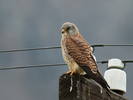search
classification
|
basic information
|
video
|
reports |
Lesser Kestrel
Falco naumanni (Fleischer, 1818)

|
 male
|
|
|
2012-05-06
Kor-Kechu, Katun River, Altai Republic. |
© Sergey Pisarevskiy
|
|
Distribution
In Siberia, steppes (including mountain ones) and extreme south of forest-steppe (Southeastern and Southwestern Transbaikal, Altai, etc). Rather rare in the region.
Biology
Breeding migrant. Inhabits the steppes with the rocky outcrops or clay-stone precipices; the low mountains with rocky gorges and foothills of main ridges. Prefers the areas of grass plains or hills with numerous locusts and other insects. In spring appears in April. Migrates in loose flocks or small groups. Breeds in colonies of one-two dozen birds but separate pairs are not rare too. Nest is built in the rock or clay cavity, between the stones; or in the cavity under the bridges; in old houses, sheep-folds or grave constructions. No special materials are used for nest construction. Rarely uses the old nests of Dove. Laying 2-7 (usually 4-5) eggs is in end April – May or in early June (probably the late nesting of first-breeders). Females incubate mainly, but males relay them for short time (male has brood patches too) and bring the food. Incubation lasts for 24-28 days. In one colony the nests with fresh eggs and the different age juveniles could be found in the same time. Both parents feed juveniles which hatch in the end of May – June and fledge at the age 35-40 days, in July – August. Repeated breeding after loss of first clutches is possible. The autumn migration to south begins in August. On migration Lesser Kestrels congregate in the loose flocks in foraging, but passage in dense flocks of some dozen birds. On roosting the one-two thousand Lesser Kestrels can be observed in convenient places. Winters in Africa.
References
В.К.Рябицев. "Птицы Сибири". Москва-Екатеринбург, Изд-во "Кабинетный ученый", 2014.













